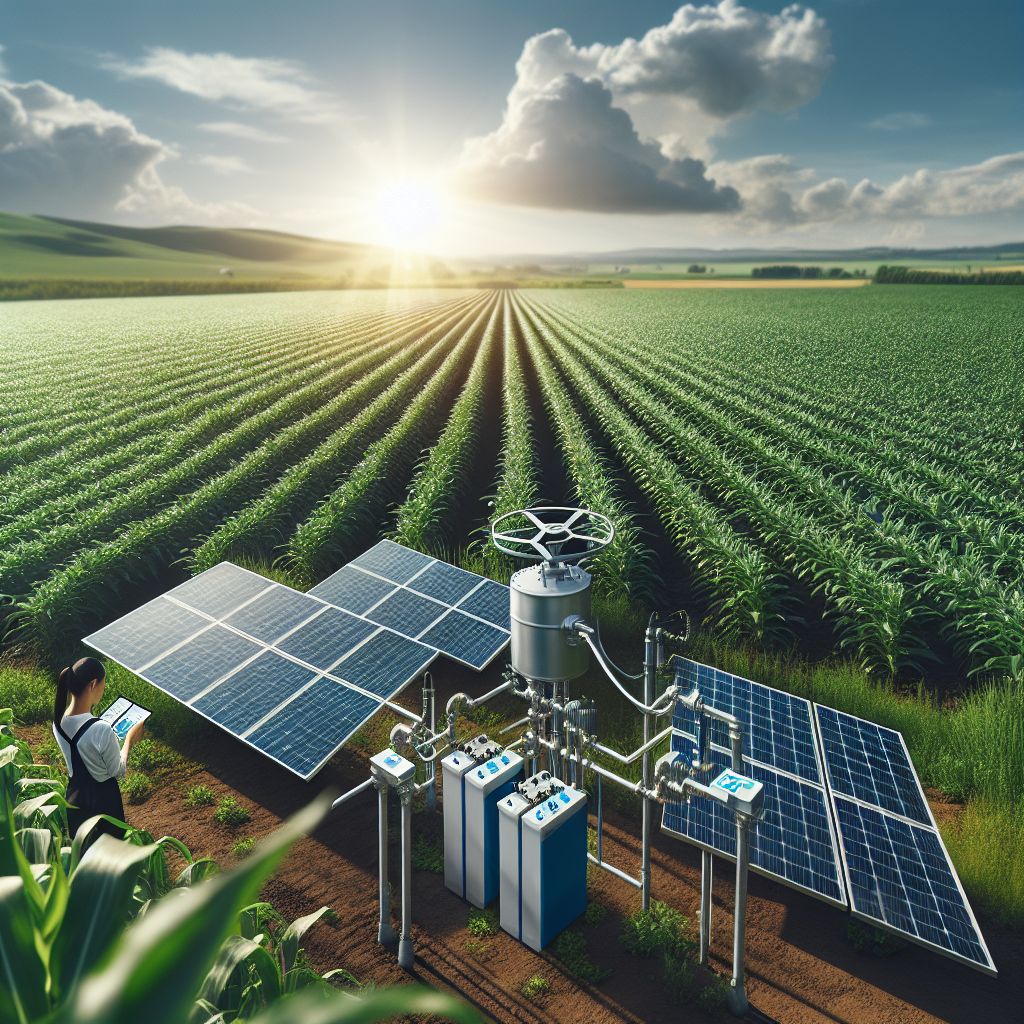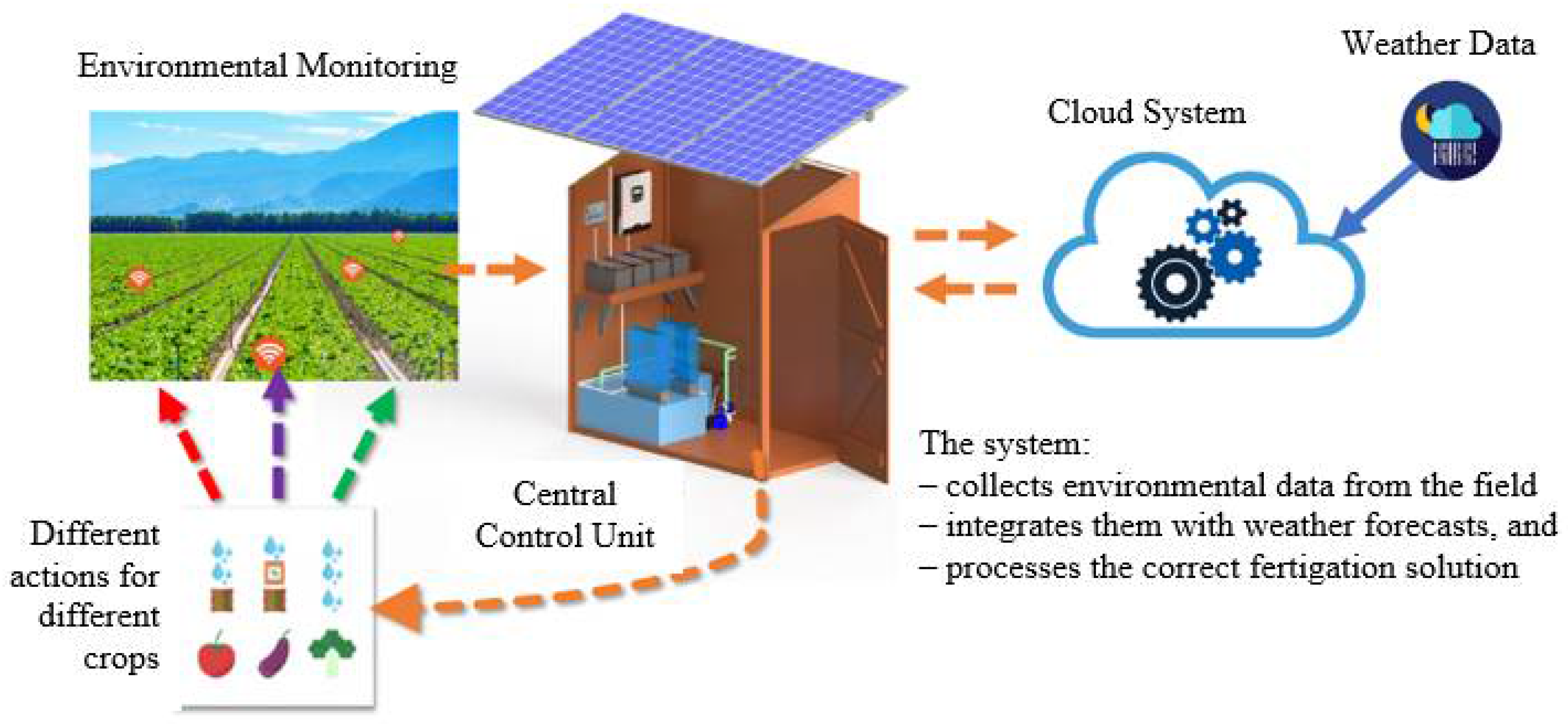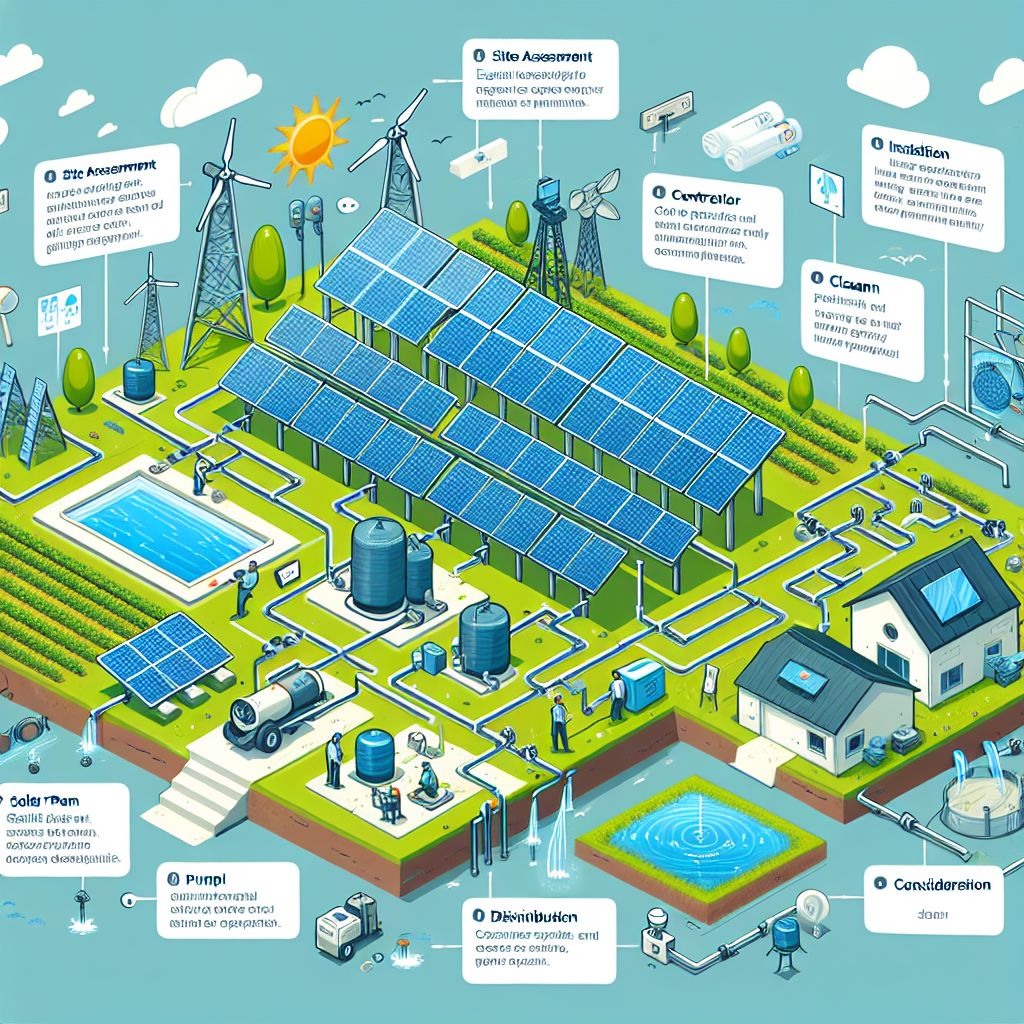
Article-at-a-Glance
-
Solar irrigation uses energy from the sun to power water pumps, providing a sustainable water source for farming.
-
Key components include solar panels, a pump, possibly a battery backup, and irrigation infrastructure.
-
It’s crucial to assess your land’s solar potential and choose the right system based on your farm’s needs.
-
While the initial investment can be significant, solar irrigation can lead to substantial cost savings and energy independence.
-
Maintenance is relatively low, but regular checks are necessary to ensure system efficiency.
Soak Up the Sun: Solar Irrigation Explained
Imagine your farm thriving with the help of the sun. Not just for growing crops, but for powering the very lifeblood of your farm – water. This isn’t a dream; it’s the reality of solar irrigation. This system captures sunlight, converts it into electricity, and uses it to pump water across your fields. It’s a game-changer for eco-efficiency and sustainability in agriculture.
The Mechanics of Solar-Powered Irrigation
Let’s dive into how this works. Solar irrigation systems consist of photovoltaic (PV) panels, a pump, and the irrigation infrastructure. The PV panels capture sunlight and convert it into electricity. This electricity then powers the pump, which draws water from your source – be it a well, lake, or reservoir – and delivers it to your crops. If you’re wondering about the nitty-gritty, the pump could be a submersible one placed underwater or a surface pump, depending on your water source.
Now, you might be thinking, “What about at night or on cloudy days?” That’s where battery backups or energy storage systems come into play. They store excess energy produced during sunny days to ensure a continuous water supply, regardless of the weather.
Why Farms are Turning to the Sky for Answers
Why the shift towards solar? Besides that, it’s an incredible use of nature’s free resource, the sun, it’s also about independence and resilience. Farms using solar irrigation break free from the unpredictability of fuel costs and the limitations of grid-tied power. Most importantly, they are taking a step towards sustainable farming practices that are kind to the planet and future generations.

Blueprint for a Sun-Driven Farm
The Heart of the System: Solar Panels in Action
The solar panels, or PV modules, are the heroes of this story. They come in various sizes and capacities, so selecting the right one is essential. They should be positioned to capture maximum sunlight, usually facing south in the Northern Hemisphere. The panels are rated by wattage, and their output determines how much water can be pumped.

From Sun to Sprout: How Solar Energy Becomes Water Flow
When the sun’s rays hit the solar panels, they create an electric current. This current is sent to the pump controller – the brains of the operation. The controller regulates the power to the pump, which then pushes water through pipes and into your irrigation system. It could be a drip system that delivers water directly to the roots of your plants or sprinklers that cover a larger area.
Battery Backups: Ensuring Water in Cloudy Climates
Battery backups are like your farm’s insurance policy. They make sure your crops get watered, even when the sun isn’t shining. These batteries store the surplus power generated during sunny periods. Think of them as a savings account for energy – you deposit when there’s plenty and withdraw when there’s a deficit.

Step-by-Step: Setting Up Solar Irrigation
Setting up a solar irrigation system is a forward-thinking move that could redefine your farming operations. But where do you begin? Let’s break it down into actionable steps that will take you from concept to watering crops with the sun’s power.
Evaluating Your Land for Solar Viability
First up, let’s see if your land is a good candidate for solar irrigation. You need a spot that gets plenty of sunlight throughout the year. Obstructions like tall buildings or trees that cast shadows can be a problem. The orientation and tilt of your solar panels also matter. They should face the sun at the right angle to catch as much light as possible. An expert can help you figure out the best setup for your specific location.
Picking the Right Pump for Your Crop’s Thirst
Choosing the right pump is like picking the best pair of shoes for a marathon; it has to be the right fit for the distance. In this case, the distance is the amount of water and the height it needs to be pumped. There are different types of solar pumps – submersible for deep wells, surface pumps for streams or ponds, and floating pumps for lakes. The one you pick depends on your water source and the needs of your crops.
Example: If you’re growing water-intensive crops like rice or cranberries, you’ll need a pump that can handle a higher water volume compared to less thirsty crops like wheat or barley.
The size of your irrigation area and the amount of water required per day will dictate the capacity of the pump you need. This will also determine the size and number of solar panels necessary to power the pump. It’s a balancing act between your water needs and the solar energy available.
When selecting a water pump for an irrigation system, considering these factors is crucial to ensure optimal performance and efficiency tailored to the specific needs of the system. Take a look at the below table to see what to consider when choosing the right water pump.
| Factor to Consider | Description |
| Pump Type | Choose between centrifugal pumps, submersible pumps, or surface pumps based on application 3 |
| Flow Rate (GPM) | Determine the required flow rate in gallons per minute for efficient water delivery 5 |
| Total Dynamic Head | Calculate the total dynamic head, which includes vertical distance and friction loss 5 |
| Horsepower | Select the appropriate horsepower based on system size and pressure requirements 3, 5 |
After selecting your pump, you’ll need to think about the irrigation method. Drip irrigation is efficient for water conservation, while sprinkler systems might be better for larger areas. Your choice will affect the design of your solar irrigation system.
The Installation Process Simplified
Installing a solar irrigation system is not a weekend DIY project. It requires careful planning and execution. Start by mounting the solar panels on sturdy supports, angled to get the maximum sunlight exposure. Connect these to the pump controller, then to the pump itself. Finally, integrate the pump with your irrigation infrastructure, be it drip lines or sprinklers.
Following these steps and considerations in this below table will help you efficiently set up a solar irrigation system on your farm, ensuring sustainable and effective crop watering practices.
|
1. Site Assessment |
– Evaluate sunlight exposure at the location. |
|
– Determine optimal placement for solar panels and water pump. | |
|
2. Solar Panel Installation |
– Mount panels securely on structures or ground mounts. |
|
– Position panels for maximum sunlight absorption. | |
|
3. Pump and Controller Setup |
– Connect water pump, controller, and storage tank as per instructions. |
|
– Ensure proper wiring and connections for efficient operation. | |
|
4. Distribution System Installation |
– Install pipes, valves, and irrigation equipment for water distribution. |
|
– Plan layout to effectively reach desired irrigation areas. | |
|
5. Regular Maintenance |
– Clean solar panels regularly for optimal energy production. |
|
– Inspect and maintain pump, controller, and connections for smooth operation. | |
|
6. Considerations Before Installation |
– Assess sunlight availability and intensity year-round. |
|
– Calculate water requirements based on irrigation needs. | |
|
– Determine system size according to water needs and available sunlight. |
The Green Thumbs Behind the Tech: Farmers Going Solar
Farmers around the world are harnessing the power of the sun to irrigate their crops. It’s a smart move that not only cuts costs but also reduces the carbon footprint of farming operations. By going solar, farmers are leading the way in sustainable agriculture.
Training and Empowerment for Sustainable Farming
For farmers to make the most of solar technology, training is key. Understanding how to operate and maintain a solar irrigation system ensures its longevity and efficiency. Many organizations and companies offer workshops and training sessions for farmers making the switch to solar.
Success Stories: Farmers and the Solar Transition
There are countless success stories of farmers who’ve made the switch to solar irrigation. Take, for instance, a farmer in California who cut his water pumping costs by 70% after installing a solar-powered system. Or a community in a remote part of Kenya where farmers now have a reliable water source for their crops, thanks to solar irrigation.
The Bright Side of Watering: Advantages Unearthed
The benefits of solar irrigation are as clear as a sunny day. Let’s shed some light on the most significant advantages. This below table will highlight the benefits of using a solar irrigation system on a farm.
| Advantage | Description |
| Irrigation in remote areas | Enables irrigation in distant locations where grid connection is not feasible 1 |
| Environmentally friendly | Utilizes renewable solar energy, reducing carbon footprint and environmental impact 1, 3 |
| No grid connection required | Operates independently of the electrical grid, providing autonomy and flexibility 1, 3 |
| No electricity bills to be paid | Eliminates ongoing electricity costs, leading to long-term financial savings 1, 3 |
| No fuel required | Relies on solar power, eliminating the need for fuel and reducing operational costs 1, 3 |
| Minimal maintenance | Offers durability and requires minimal upkeep, reducing maintenance efforts and costs 1 |
These advantages highlight the benefits of using a solar irrigation system on a farm, emphasizing sustainability, cost-effectiveness, and independence from traditional energy sources.
Cost-Cutting: Solar Savings Over Traditional Methods
Solar irrigation systems can lead to major cost savings over time. While the initial investment might be higher than traditional methods, the ongoing costs are significantly lower. You’re not paying for fuel or electricity from the grid, which means those savings go straight back into your pocket.
For example, the average cost to run a diesel pump can be several times higher than that of a solar pump over its lifetime. And because solar panels have a lifespan of around 20-25 years, you’re looking at two decades or more of savings.
Eco-Friendly Farming: Renewable Energy’s Role
Solar irrigation is a win for the environment. By using the sun’s renewable energy, you’re reducing the reliance on fossil fuels and cutting down on greenhouse gas emissions. This is a big deal in the fight against climate change and for the health of our planet.
Independence Day: Breaking Free from the Grid
With solar irrigation, farmers gain energy independence. You’re not at the mercy of power outages or fluctuating fuel prices. Your water supply is as reliable as the sunrise, giving you control over your irrigation schedule and peace of mind.
Clouds on the Horizon: Addressing Solar Irrigation’s Challenges
As with any technology, solar irrigation comes with its own set of challenges. But don’t worry, they’re not deal-breakers.
Upfront Costs: Investment Analysis and Payback Time
Yes, the upfront costs can be a hurdle. Installing a solar irrigation system is an investment. However, the payback period is getting shorter as the technology improves and becomes more affordable. Plus, there are often grants, subsidies, or financing options available to help with the initial expense.
Weathering the Weather: Reliability in Variable Climates
Performance can be affected by the weather, especially in areas with less consistent sunshine. However, with proper planning and the inclusion of battery backups or hybrid systems that can also use grid power or generators, you can mitigate these risks.
Maintenance Matters: Keeping Your System at Peak Performance
While solar irrigation systems are relatively low-maintenance, they do require some TLC. Regular cleaning of solar panels and servicing of pumps will keep your system running smoothly. Remember, a well-maintained system can last for decades.
Upfront Costs: Investment Analysis and Payback Time
The most significant barrier to adopting solar irrigation is often the initial cost. It usually costs a few thousand dollars to purchase and install a basic solar irrigation system. However, considering the long-term savings on fuel and electricity, the investment can pay for itself within a few years. Additionally, solar panels and equipment have dropped in price over the last decade, making them more accessible than ever.
For instance, if you’re spending $1,000 a year on diesel for water pumping, and a solar system costs $10,000, your payback period would be about 10 years. However, with rising fuel costs and potential savings from reduced maintenance and repair costs of diesel pumps, the payback period could be significantly shorter.
Weathering the Weather: Reliability in Variable Climates
Solar irrigation systems depend on sunlight, which can be a concern in areas with inconsistent weather. However, by using battery backups or a hybrid system that can tap into the grid or a generator, you can ensure a steady water supply. This adaptability is crucial for maintaining a reliable irrigation system year-round.
For example, a farmer in a region with a rainy season might opt for a solar system with a sizable battery bank to store excess energy during the sunny season, ensuring that water is available even during overcast periods.
Maintenance Matters: Keeping Your System at Peak Performance
Good maintenance is the key to maximizing the lifespan and efficiency of your solar irrigation system. This includes regular cleaning of solar panels to prevent dust and debris build-up, which can block sunlight and reduce efficiency. Pumps and other mechanical parts should be inspected and serviced according to the manufacturer’s recommendations to prevent breakdowns and ensure smooth operation.
Frequently Asked Questions (FAQ)
Here are some common questions about solar irrigation systems answered to help you understand how they might fit into your farming operations.
How do solar pumps provide water during nights or cloudy days?
Solar pumps can provide water during nights or cloudy days by using energy stored in batteries or by being part of a hybrid system that also uses grid power or generators. The key is to have a system designed to meet your water needs even when sunlight is not available.
Can any type of farm implement a solar irrigation system?
Yes, most farms can implement a solar irrigation system, provided they have access to a consistent water source and receive enough sunlight. The specifics of the system—such as the size and type of pump—will depend on the farm’s particular needs, including the type of crops grown and the size of the irrigated area.
What’s the expected lifespan of a solar irrigation setup?
The lifespan of a solar irrigation setup can vary, but solar panels typically last around 20-25 years. Pumps and batteries may have shorter lifespans and will likely need to be replaced or serviced during this time. With proper maintenance, the overall system can remain operational for many years, providing a good return on investment.
Are there government incentives for adopting solar irrigation?
Many regions offer government incentives for adopting solar irrigation, such as grants, tax breaks, or subsidized loans. These incentives can significantly reduce the upfront costs and shorten the payback period for farmers. It’s worth researching the incentives available in your area or consulting with a solar energy provider who can guide you through the options.
Is technical expertise required to manage a solar irrigation system?
While having some technical knowledge can be helpful, managing a solar irrigation system does not necessarily require expertise. Many systems are designed to be user-friendly, and suppliers often provide training and support. Regular maintenance tasks are straightforward and can be handled by farm staff with minimal training.






